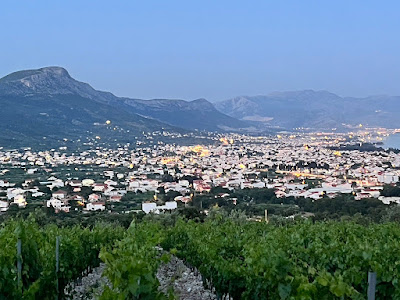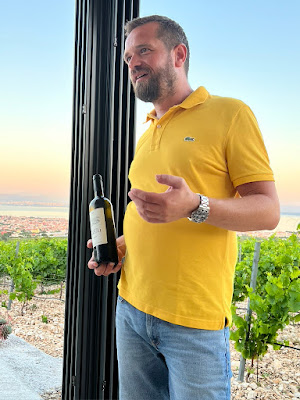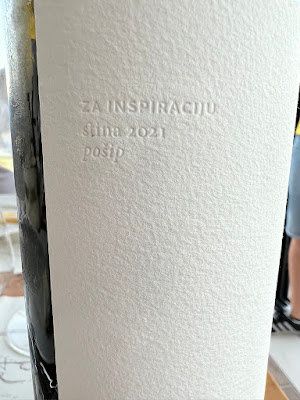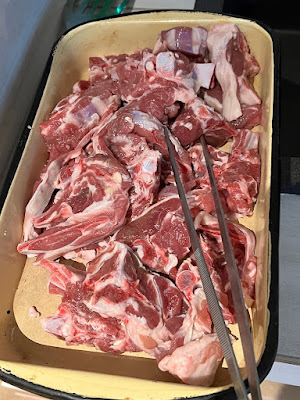At the end of our two week tour of Croatia, the last winery we visited was the Kastel Sikuli Winery, located in Kaštel Novi ("New Castle") in Dalmatia. It is almost hidden, high in the mountains, and with breathtaking views of the Bay of Kaštel, several islands within the bay, and the city of Split. Besides a wine tasting, we also had dinner at the winery, and we got to watch how the view changed, from day to night, as the sun set and the lights of Split illuminated the region.
Kastel Sikuli Winery is a relatively new winery, established in 2009 by the Kovačević family. Ivica Kovačević is the director of the Jako Vino winery on Brač, and eventually chose to start his own winery with his two sons, Ivan and Tomislav. The vineyard where the wine tasting took place had been planted in 2008, and it had previously contained 10-15 different varieties, with about 50% Plavac Mali. However, Ivan told us that the site isn't the best for Plavac Mali, as it's a late ripening grape and the area gets colder earlier.
The winery's name was inspired by the name of an ancient Greek settlement, Sikuli, which was settled around the 2nd century BC. Sikuli would later back the ancient Roman Pompey, but when he fell out of favor, the settlement lost favor and Split became more prominent. In the 1870s, the remains of Sikuli were discovered, along with many wine amphorae and glassware, showing the importance of wine to that ancient community.
The vineyard is only about one hectare, and we saw plenty of Pošip vines, but there was some Tribidag there as well. They are constructing a new winery at this location, and once that is finished, they will plant more vineyards. The winery also owns a couple smaller vineyards in the "hinterlands" of Dalmatia where they grow some international grapes, making wines like a Merlot Rosé.
Their Kaštel Novi vineyards have many, many stones, making the vines struggle for survival, perfect for the grapes.
Ivan Kovačević led us through our wine tasting and dinner although we would later meet his father, Ivica, as well. Ivan previously worked in software/management and last Spring, he first started working full time at the winery. He was personable and down-to-earth, and it was a pleasure chatting with him. The winery currently produces about 10,000 bottles annually, although they expect to grow, to a production of up to 45,000 bottles. Currently, they are producing Pošip, Rosé, and Tribidag.
We began our tasting with a wine from the Stina Winery on Brač Island, where Ivica is the director. It is believed that the ancient Greeks introduced the first vines to the island around the 5th century BC. Brač is also well known for its white stones, which were used to construct various buildings and it's even said that some of their stone was used in the construction of the U.S. White House. The name "Stina" means "stone." The white label for this wine is intended to reflect that white stone, but it's primarily used on wines sold to restaurants and places (but not wine shops) that tell stories.
The Stina Winery extends back to 1903, and its vineyards are generally atop crushed stone, making the vines struggle. The 2021 Stina Vugava "Za Inspiraciju" ("For Inspiration"), with a 12.5% ABV, is produced from Vugava, a grape that originated on the island of Vis. There are legends that the grape was introduced to the island by the ancient Greek, but there is no proof of such. The wine had fruity aromatics with a hint of a floral element, and on the palate it was fresh, dry and crisp, with flavors of apple and pear, and a backbone of minerality. Very pleasant wine.
The 2021 Stina Pošip Za Inspiraciju, with a 13% ABV, was fresh, dry and crisp, with pleasing flavors of citrus and grapefruit, with a nice minerality and a hint of almonds. An excellent wine for oysters and other seafood.
In comparison, we then tasted the 2020 Kastel Sikuli Pošip, where 20% of the wine aged sur lie in barrique, and the rest in stainless steel. It was very aromatic, and on the palate it was dry, fresh, and crisp, with a greater depth and complexity of flavor than the Stina, as well as more savory notes. Tasty flavors of citrus, peach and almonds, minerality, and subtle spices. Ivan noted that this wine is better with some age in the bottle. A more serious Pošip, which also shows its potential for aging. Highly recommended.
Our first dinner course was a Risotto with Shrimp, topped by a cream of mixed cheeses. Quite delicious, the rice cooked just right, with a creamy texture and tender shrimp.
We next tasted the 2021 Merlot Rosé, which had just been bottled a few days previously so no label had been printed yet. Light pink in color, at 12% ABV, it was dry, fruity and easy drinking. Nice red fruit flavors with good acidity.
The 2019 Kastel Skuli Kaštelanski Crljenak ('the red from Kaštela") is produced from Tribidag, which is more well known outside of Croatia as Zinfandel, although it's most likely the grape originated in Dalmatia. There's even a historical mention from the 15th century of Tribidag. With a 14% ABV, the wine underwent a long maceration, to bring our the aromatics, and then was aged for a year in barrique. With a dark red color, the wine possessed an intriguing nose of black fruit and spices, and on the palate, it presented a complex melange of flavors, including black cherry, raisins, blueberries, vanilla, spices, and figs. Smooth tannins, excellent acidity, well balanced, and with a lingering, satisfying finish. Highly recommended.
The outside grill was started, and note the Peka in the top picture!
Our main course was Lamb, a favorite meat of mine.
Grilling the lamb.
With the grilled lamb, there were potatoes, carrots and little, fried balls, similar to arancini. The presentation was excellent, and the food equally so. A delicious sear on the tender lamb.
The final wine was the 2017 Stina Plavac Mali Majstor Za Inspiraciju, a single vineyard Plavac Mali. With a 14% ABV, there were bright notes of cherry on the nose, and on the palate, it was dry, elegant and smooth, with cherry, plum, and blackberry flavors, with good acidity, mild spices, and a touch of earthiness. A very good choice for the lamb.




















No comments:
Post a Comment